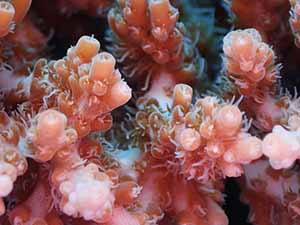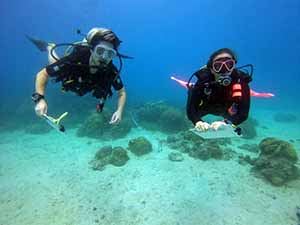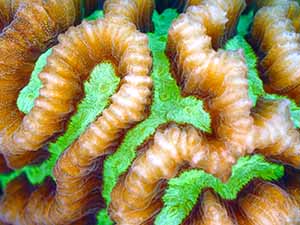RESTORING REEFS BACK TO LIFE
COMBINING SIMPLE TECHNIQUES WITH EXPERT KNOWLEDGE



Coral reefs are damaged due to changing water temperatures, ocean acidification, pollution, invasive species, changing weather patterns, and physical impacts.
It is estimated that the world has lost 30 to 50 percent of its coral reefs already.
By creating an artificial reefs we can assist nature by providing an alternative dive site and providing substrate for coral transplants and for natural recruits. In Thailand, this is only allowed by special permission from the Department of Marine and Coastal Resources.
HOW DOES IT WORK ?
Preparation
Participating in active coral restoration requires comprehensive knowledge, training, and authorisation.
Diving
Coral restoration activities involve tasks such as cleaning, repairing and monitoring coral health.
Transplanting
Coral transplantation can only be conducted by DMCR approved divers in certain locations, however volunteers can help.
Long Term
Regular monitoring and maintenance of restoration areas are essential for assessing and enhancing coral reef health.
WHY CORAL RESTORATION ?

By harnessing corals that have been fragmented due to natural occurrences, interactions with marine life, or human activities, we provide them with a lifeline by attaching them to sturdy structures using a diverse range of techniques.
Corals anchored in environments that offer good condtions for growth will flourish as long as they remain secure, eventually becoming integral components of the artificial reef’s framework, attracting other marine species to inhabit it.
Nonetheless, effective coral reef restoration demands a comprehensive approach beyond solely focusing on coral transplantation.
CORAL RESTORATION FACTS
Without substantial intervention, tropical reef ecosystems may confront global extinction by the century’s end.
Charles Darwin stands as the world’s pioneer coral restorationist, pioneering the practice of securing broken coral fragments in bamboo.
Transplants from coral nurseries are relocated to either artificial structures or back onto the natural reef.
Frequent maintenance is imperative to guarantee transplants achieve a high survival rate.

GET INVOLVED !



Considerable time, energy, and resources are dedicated to the upkeep of coral restoration projects.
There is a constant list of tasks aimed at maximising the survival rate of coral fragments.
Promoting diversity in coral species holds paramount importance in coral restoration efforts. Greater diversity enhances resilience, enabling corals to better withstand or rebound from disturbances.
Take a 2 day Introduction to Coral Reef Restoration or even embark on a Marine Conservation Internship with our partners at The Coral Tribe to actively engage in local and global coral restoration initiatives and reef research.
Book the 2 day coral restoration course
This course is designed to teach you about coral reefs, their benefits and the issues they face globally.
To help restore coral reefs, we are approved by the Department of Marine & Coastal Resources to transplant coral, which is one of the ways that we partake in Coral Restoration.
This course will also take you through the stages of transplanting and techniques of using “Corals of Opportunity” to rebuild impacted areas.
* 2 Days & 4 Dives.
* Basic Coral Ecology presentation.
* All materials and dive equipment included.
* Learn different coral restoration techniques.
* Visit our research and artificial dive site.
* Assist our certified coral transplant team.
฿8,000
GET MORE INFO !
If you have questions, about any of our projects, citizen science, research, volunteering, internships or training.
Please get in touch with our marine conservation team!



